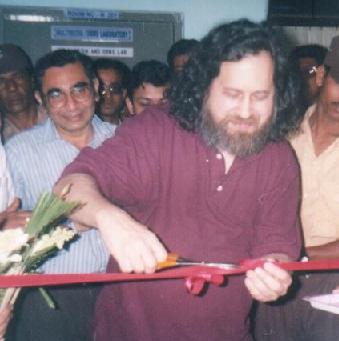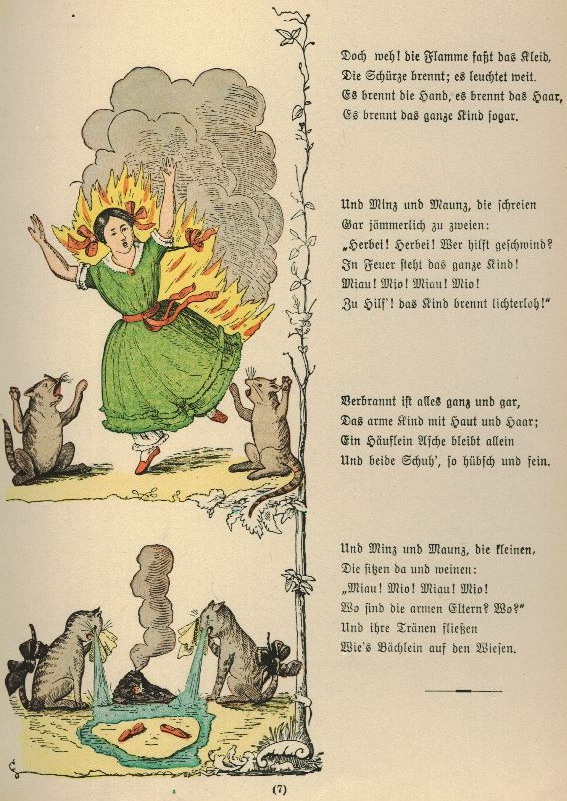|
The Right To Read
''The Right to Read'' is a short story by Richard Stallman, the founder of the Free Software Foundation, which was first published in 1997 in Communications of the ACM. It is a cautionary tale set in the year 2047, when DRM-like technologies are employed to restrict the readership of books; when the sharing of books and written material is a crime punishable by imprisonment. In particular, the story touches on the impact of such a system on university students, due to their need for materials, one (Dan Halbert) of whom is forced into a dilemma in which he must decide whether to loan his computer to a fellow student (Lissa Lenz), who would then have the ability to illegally access his purchased documents. It is notable for being written before the use of Digital Rights Management (DRM) technology was widespread (although DVD video discs which used DRM had appeared the year before, and various proprietary software since the 1970s had made use of some form of copy protection), and fo ... [...More Info...] [...Related Items...] OR: [Wikipedia] [Google] [Baidu] |
Short Story
A short story is a piece of prose fiction that typically can be read in one sitting and focuses on a self-contained incident or series of linked incidents, with the intent of evoking a single effect or mood. The short story is one of the oldest types of literature and has existed in the form of legends, mythic tales, folk tales, fairy tales, tall tales, fables and anecdotes in various ancient communities around the world. The modern short story developed in the early 19th century. Definition The short story is a crafted form in its own right. Short stories make use of plot, resonance, and other dynamic components as in a novel, but typically to a lesser degree. While the short story is largely distinct from the novel or novella/short novel, authors generally draw from a common pool of literary techniques. The short story is sometimes referred to as a genre. Determining what exactly defines a short story has been recurrently problematic. A classic definition of a short story ... [...More Info...] [...Related Items...] OR: [Wikipedia] [Google] [Baidu] |
Richard Stallman
Richard Matthew Stallman (; born March 16, 1953), also known by his initials, rms, is an American free software movement activist and programmer. He campaigns for software to be distributed in such a manner that its users have the freedom to use, study, distribute, and modify that software. Software that ensures these freedoms is termed free software. Stallman launched the GNU Project, founded the Free Software Foundation (FSF) in October 1985, developed the GNU Compiler Collection and GNU Emacs, and wrote the GNU General Public License. Stallman launched the GNU Project in September 1983 to write a Unix-like computer operating system composed entirely of free software. With this, he also launched the free software movement. He has been the GNU project's lead architect and organizer, and developed a number of pieces of widely used GNU software including, among others, the GNU Compiler Collection, GNU Debugger, and GNU Emacs text editor. Stallman pioneered the concept of copyl ... [...More Info...] [...Related Items...] OR: [Wikipedia] [Google] [Baidu] |
Free Software Foundation
The Free Software Foundation (FSF) is a 501(c)#501(c)(3), 501(c)(3) non-profit organization founded by Richard Stallman on October 4, 1985, to support the free software movement, with the organization's preference for software being distributed under copyleft ("share alike") terms, such as with its own GNU General Public License. The FSF was incorporated in Boston, Massachusetts, United States, US, where it is also based. From its founding until the mid-1990s, FSF's funds were mostly used to employ software developers to write free software for the GNU Project. Since the mid-1990s, the FSF's employees and volunteers have mostly worked on legal and structural issues for the free software movement and the free software community. Consistent with its goals, the FSF aims to use only free software on its own computers. History The Free Software Foundation was founded in 1985 as a Nonprofit corporation, non-profit corporation supporting free software development. It continued existi ... [...More Info...] [...Related Items...] OR: [Wikipedia] [Google] [Baidu] |
Communications Of The ACM
''Communications of the ACM'' is the monthly journal of the Association for Computing Machinery (ACM). It was established in 1958, with Saul Rosen as its first managing editor. It is sent to all ACM members. Articles are intended for readers with backgrounds in all areas of computer science and information systems. The focus is on the practical implications of advances in information technology and associated management issues; ACM also publishes a variety of more theoretical journals. The magazine straddles the boundary of a science magazine, trade magazine, and a scientific journal. While the content is subject to peer review, the articles published are often summaries of research that may also be published elsewhere. Material published must be accessible and relevant to a broad readership. From 1960 onward, ''CACM'' also published algorithms, expressed in ALGOL. The collection of algorithms later became known as the Collected Algorithms of the ACM. See also * ''Journal of the A ... [...More Info...] [...Related Items...] OR: [Wikipedia] [Google] [Baidu] |
Cautionary Tale
A cautionary tale is a tale told in folklore to warn its listener of a danger. There are three essential parts to a cautionary tale, though they can be introduced in a large variety of ways. First, a taboo or prohibition is stated: some act, location, or thing is said to be dangerous. Then, the narrative itself is told: someone disregarded the warning and performed the forbidden act. Finally, the violator comes to an unpleasant fate, which is frequently related in expansive and grisly detail. Cautionary tales and conformity Cautionary tales are ubiquitous in popular culture; many urban legends are framed as cautionary tales: from the lover's lane haunted by a hook-handed murderer to the tale of a man who shot a cactus for fun only to die when the plant toppled onto him. Like horror fiction, generally the cautionary tale exhibits an ambivalent attitude towards social taboos. The narrator of a cautionary tale is momentarily excused from the ordinary demands of etiquette that di ... [...More Info...] [...Related Items...] OR: [Wikipedia] [Google] [Baidu] |
Digital Rights Management
Digital rights management (DRM) is the management of legal access to digital content. Various tools or technological protection measures (TPM) such as access control technologies can restrict the use of proprietary hardware and copyrighted works. DRM technologies govern the use, modification, and distribution of copyrighted works (such as software and multimedia content), as well as systems that enforce these policies within devices. Laws in many countries criminalize the circumvention of DRM, communication about such circumvention, and the creation and distribution of tools used for such circumvention. Such laws are part of the United States' Digital Millennium Copyright Act (DMCA), and the European Union's Information Society Directive (the French DADVSI is an example of a member state of the European Union implementing the directive). DRM techniques include licensing agreements and encryption. The industry has expanded the usage of DRM to various hardware products, such as K ... [...More Info...] [...Related Items...] OR: [Wikipedia] [Google] [Baidu] |
Copy Protection
Copy protection, also known as content protection, copy prevention and copy restriction, describes measures to enforce copyright by preventing the reproduction of software, films, music, and other media. Copy protection is most commonly found on videotapes, DVDs, Blu-ray discs, HD-DVDs, computer software discs, video game discs and cartridges, audio CDs and some VCDs. Some methods of copy protection have also led to criticism because it caused inconvenience for paying consumers or secretly installed additional or unwanted software to detect copying activities on the consumer's computer. Making copy protection effective while protecting consumer rights remains a problem with media publication. Terminology Media corporations have always used the term copy protection, but critics argue that the term tends to sway the public into identifying with the publishers, who favor restriction technologies, rather than with the users. Copy prevention and copy control may be more neutral ... [...More Info...] [...Related Items...] OR: [Wikipedia] [Google] [Baidu] |
Trusted Computing
Trusted Computing (TC) is a technology developed and promoted by the Trusted Computing Group. The term is taken from the field of trusted systems and has a specialized meaning that is distinct from the field of Confidential Computing. The core idea of trusted computing is to give hardware manufacturers control over what software does and does not run on a system by refusing to run unsigned software. With Trusted Computing, the computer will consistently behave in expected ways, and those behaviors will be enforced by computer hardware and software. Enforcing this behavior is achieved by loading the hardware with a unique encryption key that is inaccessible to the rest of the system and the owner. TC is controversial as the hardware is not only secured for its owner, but also secured ''against its owner''. Such controversy has led opponents of trusted computing, such as free software activist Richard Stallman, to refer to it instead as ''treacherous computing'', even to the point wh ... [...More Info...] [...Related Items...] OR: [Wikipedia] [Google] [Baidu] |
The Digital Imprimatur
John Walker is a computer programmer, author and co-founder of the computer-aided design software company Autodesk. He has more recently been recognized for his writing on his website Fourmilab. Early projects In 1974/1975, Walker wrote the ANIMAL software, which self-replicated on UNIVAC 1100 machines. It is considered one of the first computer viruses. Walker also founded the hardware integration manufacturing company Marinchip. Among other things, Marinchip pioneered the translation of numerous computer language compilers to Intel platforms. Autodesk In 1982, John Walker and 12 other programmers pooled US$59,000 to start Autodesk (AutoCAD), and began working on several computer applications. The first completed was AutoCAD, a software application for computer-aided design (CAD) and drafting. AutoCAD had begun life as ''Interact'', a CAD, written by programmer Michael Riddle in a proprietary language. Walker and Riddle rewrote the program, and established a profit-sharin ... [...More Info...] [...Related Items...] OR: [Wikipedia] [Google] [Baidu] |
Digital Rights Management
Digital rights management (DRM) is the management of legal access to digital content. Various tools or technological protection measures (TPM) such as access control technologies can restrict the use of proprietary hardware and copyrighted works. DRM technologies govern the use, modification, and distribution of copyrighted works (such as software and multimedia content), as well as systems that enforce these policies within devices. Laws in many countries criminalize the circumvention of DRM, communication about such circumvention, and the creation and distribution of tools used for such circumvention. Such laws are part of the United States' Digital Millennium Copyright Act (DMCA), and the European Union's Information Society Directive (the French DADVSI is an example of a member state of the European Union implementing the directive). DRM techniques include licensing agreements and encryption. The industry has expanded the usage of DRM to various hardware products, such as K ... [...More Info...] [...Related Items...] OR: [Wikipedia] [Google] [Baidu] |
Free Software
Free software or libre software is computer software distributed under terms that allow users to run the software for any purpose as well as to study, change, and distribute it and any adapted versions. Free software is a matter of liberty, not price; all users are legally free to do what they want with their copies of a free software (including profiting from them) regardless of how much is paid to obtain the program.Selling Free Software (gnu.org) Computer programs are deemed "free" if they give end-users (not just the developer) ultimate control over the software and, subsequently, over their devices. The right to study and modify a computer program entails that |





